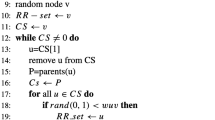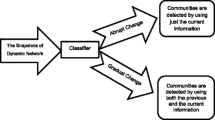Abstract
Community detection in dynamic networks is of great importance in social network analysis. For instance, online social networks such as Facebook, WhatsApp and LinkedIn are rapidly evolving with time. However, the majority of previous research have focused on community detection in static networks. It is computationally expensive to repeatedly use a static algorithm on snapshots of dynamic networks. In this paper, we propose a community detection algorithm namely, Tie Strength based Incremental Community detection (TSInc), aiming to find communities and track the dynamic events in each snapshot. TSInc determines communities using tie strength based information cascades. Following the initial snapshot, we construct a new subgraph based on the dynamic events in the subsequent snapshots and quickly assign communities. These communities in combination with the unchanged communities are merged to obtain the inherent community structure. These procedure is repeated for the remaining snapshots as well. Experimental results on several real-world dynamic networks and state-of-the-art approaches shows that TSInc algorithm outperforms the baseline algorithms in terms of effectiveness of the detected communities.







Similar content being viewed by others
Data availability
Data available on request.
References
Khanday AMUD, Khan QR, Rabani ST (2021) Identifying propaganda from online social networks during COVID-19 using machine learning techniques. Int J Inf Technol 13:115–122
Das S, Biswas A (2021) Deployment of information diffusion for community detection in online social networks: a comprehensive review. IEEE Trans Comput Soc Syst 8:1083–1107
Devi MD, Saharia N (2023) Identification of domain-specific euphemistic tweets using clustering. Int J Inf Technol, 1–11
Lavanya KG, Dhanalakshmi P, Nandhini M (2023) Computerized segmentation of MR brain tumor: an integrated approach of multi-modal fusion and unsupervised clustering. Int J Inf Technol, 1–15
Lorenzo G, Lorenzo-Lledó A (2024) The use of artificial intelligence for detecting the duration of autistic students’ emotions in social interaction with the NAO robot: a case study. Int J Inf Technol, 1–7
Paramasivam A, Nirmala SJ (2023) SSC-CF: Semantic similarity and clustering-based collaborative filtering for expert recommendation in community question answering websites. Int J Info Technol 15:4243–4257
Das S, Biswas A (2022) DCC: a cascade based approach to detect communities in social networks. arXiv preprint arXiv:2212.10937
Das S, Biswas A (2021) Community detection in social networks using local topology and information exchange. In: 2021 international conference on intelligent technologies (CONIT), IEEE, pp 1–7
Aggarwal C, Subbian K (2014) Evolutionary network analysis: a survey. ACM Comput Surv (CSUR) 47:1–36
Asur S, Parthasarathy S, Ucar D (2009) An event-based framework for characterizing the evolutionary behavior of interaction graphs. ACM Trans Knowl Discov Data (TKDD) 3:1–36
Tang X, Yang CC (2014) Detecting social media hidden communities using dynamic stochastic blockmodel with temporal dirichlet process. ACM Trans Intell Syst Technol (TIST) 5:1–21
Das S, Singha B, Tonda A, Biswas A (2023) Direct Comparative analysis of nature-inspired optimization algorithms on community detection problem in social networks. In: mobile computing and sustainable informatics: proceedings of ICMCSI, Springer, pp 629-642
Rossetti G, Cazabet R (2018) Community discovery in dynamic networks: a survey. ACM Comput Surv (CSUR) 51:1–37
Saxena A (2022) Evolving models for dynamic weighted complex networks. Principles of social networking: the new horizon and emerging challenges 177–208
Sun Z, Sheng J, Wang B, Ullah A, Khawaja F (2020) Identifying communities in dynamic networks using information dynamics. Entropy 22:1–25
Sun Z, Sun Y, Chang X, Wang Q, Yan X, Pan Z, Li ZP (2020) Community detection based on the Matthew effect. Knowl-Based Syst 205:1–20
Su X, Cheng J, Yang H, Leng M, Zhang W, Chen X (2020) IncNSA: DEtecting communities incrementally from time-evolving networks based on node similarity. Int J Mod Phys C 31:2050094
Greene D, Doyle D, Cunningham P (2010) Tracking the evolution of communities in dynamic social networks. In: 2010 international conference on advances in social networks analysis and mining, pp 176–183
Gauvin L, Panisson A, Cattuto C (2014) Detecting the community structure and activity patterns of temporal networks: a non-negative tensor factorization approach. PLoS ONE 9:1–13
Fadaei A, Khasteh SH (2019) Enhanced K-Means re-clustering over dynamic networks. Expert Syst Appl 132:126–140
Chakrabarti D, Kumar R, Tomkins A (2006) Evolutionary Clustering. In: Proceedings of the 12th ACM SIGKDD international conference on knowledge discovery and data mining, Philadelphia, PA, USA, pp 554–560
Chen YC, Chen YL, Lu JY (2021) MK-Means: detecting evolutionary communities in dynamic networks. Expert Syst Appl 176:1–11
Chi Y, Song X, Zhou D, Hino K, Tseng BL (2009) On evolutionary spectral clustering. ACM Trans Knowl Discov Data 3:1–30
Amelio A, Pizzuti C (2017) Evolutionary clustering for mining and tracking dynamic multilayer networks. Comput Intell 33:181–209
Folino F, Pizzuti C (2013) An evolutionary multiobjective approach for community discovery in dynamic networks. IEEE Trans Knowl Data Eng 26:1838–1852
Li W, Zhu H, Li S, Wang H, Dai H, Wang C, Jin Q (2021) Evolutionary community discovery in dynamic social networks via resistance distance. Expert Syst Appl 171:1–12
Yin Y, Zhao Y, Li H, Dong X (2021) Multi-objective evolutionary clustering for large-scale dynamic community detection. Inf Sci 549:269–287
Ma X, Dong D (2017) Evolutionary nonnegative matrix factorization algorithms for community detection in dynamic networks. IEEE Trans Knowl Data Eng 29:1045–1058
Hu Y, Zhang Y, Wang X, Wu J, Duo B (2022) A local seeding algorithm for community detection in dynamic networks. In: International conference on advanced data mining and applications, Springer, pp 97–112
Cordeiro M, Sarmento RP, Gama J (2016) Dynamic community detection in evolving networks using locality modularity optimization. Soc Netw Anal Min 6:1–20
Tabarzad MA, Hamzeh A (2018) Incremental community miner for dynamic networks. Appl Intell 48:1–22
Agarwal P, Verma R, Agarwal A, Chakraborty T (2018) DyPerm: Maximizing permanence for dynamic community detection. In: Pacific-Asia conference on knowledge discovery and data mining, Springer, Australia, pp 437–449
Chong WH, Teow LN (2013) An incremental batch technique for community detection. In: Proceedings of the 16th international conference on information fusion, IEEE, pp 750–757
Zhuang D, Chang JM, Li M (2019) DynaMo: Dynamic community detection by incrementally maximizing modularity. IEEE Trans Knowl Data Eng 33:1934–1945
Sociopatterns, http://www.sociopatterns.org/datasets/, Accessed 25 Nov, 2023
Yang S (2013) Networks: an introduction by MEJ Newman. Taylor & Francis, Oxford
Brandes U, Gaertler M, Wagner D (2003)Experiments on graph clustering algorithms. In: Algorithms-ESA 2003: 11th Annual European Symposium, Springer, Budapest, Hungary, pp 568–579
Biswas A, Biswas B (2017) Defining quality metrics for graph clustering evaluation. Expert Syst Appl 71:1–17
Biswas A, Biswas B (2015) Investigating community structure in perspective of ego network. Expert Syst Appl 42:6913–6934
Rossetti G, Milli L, Cazabet R (2019) Cdlib: a python library to extract, compare and evaluate communities from complex networks. Appl Netw Sci 4:1–26
Author information
Authors and Affiliations
Corresponding author
Ethics declarations
Conflict of interest
The authors declare that they have no Conflict of interest.
Rights and permissions
Springer Nature or its licensor (e.g. a society or other partner) holds exclusive rights to this article under a publishing agreement with the author(s) or other rightsholder(s); author self-archiving of the accepted manuscript version of this article is solely governed by the terms of such publishing agreement and applicable law.
About this article
Cite this article
Das, S., Biswas, A. TSInc: Tie strength based incremental community detection using information cascades. Int. j. inf. tecnol. (2024). https://doi.org/10.1007/s41870-024-01844-8
Received:
Accepted:
Published:
DOI: https://doi.org/10.1007/s41870-024-01844-8




